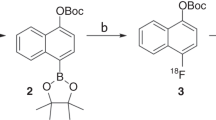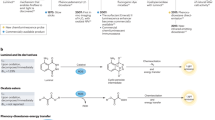Abstract
A previous study reported the use of luminol for the detection of myeloperoxidase (MPO) activity using optical imaging in infiltrating neutrophils under inflammatory disease conditions. The detection is based on a photon-emitting reaction between luminol and an MPO metabolite. Because of tissue absorption and scattering, however, luminol-emitted blue light can be efficiently detected from superficial inflammatory foci only. In this study we report a chemiluminescence resonance energy transfer (CRET) methodology in which luminol-generated blue light excites nanoparticles to emit light in the near-infrared spectral range, resulting in remarkable improvement of MPO detectability in vivo. CRET caused a 37-fold increase in luminescence emission over luminol alone in detecting MPO activity in lung tissues after lipopolysaccharide challenge. We demonstrated a dependence of the chemiluminescent signal on MPO activity using MPO-deficient mice. In addition, co-administration of 4-aminobenzoic acid hydrazide (4-ABAH), an irreversible inhibitor of MPO, significantly attenuated luminescent emission from inflamed lungs. Inhibition of nitric oxide synthase with a nonspecific inhibitor, L-NAME, had no effect on luminol-mediated chemiluminescence production. Pretreatment of mice with MLN120B, a selective inhibitor of IKK-2, resulted in suppression of neutrophil infiltration to the lung tissues and reduction of MPO activity. We also demonstrated that CRET can effectively detect MPO activity at deep tissue tumor foci due to tumor development–associated neutrophil infiltration. We developed a sensitive MPO detection methodology that provides a means for visualizing and quantifying oxidative stress in deep tissue. This method is amenable to rapid evaluation of anti-inflammatory agents in animal models.
This is a preview of subscription content, access via your institution
Access options
Subscribe to this journal
Receive 12 print issues and online access
$209.00 per year
only $17.42 per issue
Buy this article
- Purchase on Springer Link
- Instant access to full article PDF
Prices may be subject to local taxes which are calculated during checkout





Similar content being viewed by others
References
Haegens, A., Vernooy, J.H., Heeringa, P., Mossman, B.T. & Wouters, E.F. Myeloperoxidase modulates lung epithelial responses to pro-inflammatory agents. Eur. Respir. J. 31, 252–260 (2008).
Winterbourn, C.C. Reconciling the chemistry and biology of reactive oxygen species. Nat. Chem. Biol. 4, 278–286 (2008).
Davies, M.J., Hawkins, C.L., Pattison, D.I. & Rees, M.D. Mammalian heme peroxidases: from molecular mechanisms to health implications. Antioxid. Redox Signal. 10, 1199–1234 (2008).
O'Donnell, C. et al. 3-chlorotyrosine in sputum of COPD patients: relationship with airway inflammation. COPD 7, 411–417 (2010).
Hazen, S.L. & Heinecke, J.W. 3-chlorotyrosine, a specific marker of myeloperoxidase-catalyzed oxidation, is markedly elevated in low density lipoprotein isolated from human atherosclerotic intima. J. Clin. Invest. 99, 2075–2081 (1997).
Malle, E., Furtmüller, P.G., Sattler, W. & Obinger, C. Myeloperoxidase: a target for new drug development? Br. J. Pharmacol. 152, 838–854 (2007).
Kettle, A.J., Gedye, C.A. & Winterbourn, C.C. Mechanism of inactivation of myeloperoxidase by 4-aminobenzoic acid hydrazide. Biochem. J. 321, 503–508 (1997).
Gross, S. et al. Bioluminescence imaging of myeloperoxidase activity in vivo. Nat. Med. 15, 455–461 (2009).
Altinoğlu, E.I. & Adair, J.H. Near infrared imaging with nanoparticles. Wiley Interdiscip. Rev. Nanomed. Nanobiotechnol. 2, 461–477 (2010).
So, M.-K., Xu, C., Loening, A.M., Gambhir, S.S. & Rao, J. Self-illuminating quantum dot conjugates for in vivo imaging. Nat. Biotechnol. 24, 339–343 (2006).
Wang, H.Q. et al. Influence of quantum dot's quantum yield to chemiluminescent resonance energy transfer. Anal. Chim. Acta 610, 68–73 (2008).
Ansaldi, D. et al. Imaging pulmonary NF-κB activation and therapeutic effects of MLN120B and TDZD-8. PLoS ONE 6, e25093 (2011).
Orita, T., Shimozaki, K., Murakami, H. & Nagata, S. Binding of NF-Y transcription factor to one of the cis-elements in the myeloperoxidase gene promoter that responds to granulocyte colony-stimulating factor. J. Biol. Chem. 272, 23216–23223 (1997).
Wu, X. et al. Immunofluorescent labeling of cancer marker Her2 and other cellular targets with semiconductor quantum dots. Nat. Biotechnol. 21, 41–46 (2003).
Medintz, I.L., Uyeda, H.T., Goldman, E.R. & Mattoussi, H. Quantum dot bioconjugates for imaging, labeling and sensing. Nat. Mater. 4, 435–446 (2005).
Chan, W.C. & Nie, S. Quantum dot bioconjugates for ultrasensitive nonisotopic detection. Science 281, 2016–2018 (1998).
Michel, O. et al. Severity of asthma is related to endotoxin in house dust. Am. J. Respir. Crit. Care Med. 154, 1641–1646 (1996).
Linden, M. et al. Airway inflammation in smokers with nonobstructive and obstructive chronic bronchitis. Am. Rev. Respir. Dis. 148, 1226–1232 (1993).
Homayoun, H., Khavandgar, S. & Dehpour, A.R. The involvement of endogenous opioids and nitricoxidergic pathway in the anticonvulsant effects of foot-shock stress in mice. Epilepsy Res. 49, 131–142 (2002).
Nuchprayoon, I. et al. PEBP2/CBF, the murine homolog of the human myeloid AML1 and PEBP2β/CBFβ proto-oncoproteins, regulates the murine myeloperoxidase and neutrophil elastase genes in immature myeloid cells. Mol. Cell Biol. 14, 5558–5568 (1994).
Shen, W., Gan, J., Xu, S., Jiang, G. & Wu, H. Penehyclidine hydrochloride attenuates LPS-induced acute lung injury involvement of NF-κB pathway. Pharmacol. Res. 60, 296–302 (2009).
Islam, M.S. et al. Anti-inflammatory effects of phytosteryl ferulates in colitis induced by dextran sulphate sodium in mice. Br. J. Pharmacol. 154, 812–824 (2008).
Nagashima, K. et al. Rapid TNFR1-dependent lymphocyte depletion in vivo with a selective chemical inhibitor of IKKβ. Blood 107, 4266–4273 (2006).
Schultz, J. & Kaminker, K. Myeloperoxidase of the leucocyte of normal human blood. I. Content and localization. Arch. Biochem. Biophys. 96, 465–467 (1962).
Bos, A., Wever, R. & Roos, D. Characterization and quantification of the peroxidase in human monocytes. Biochim. Biophys. Acta 525, 37–44 (1978).
Gregory, A.D. & Houghton, A.M. Tumor-associated neutrophils: new targets for cancer therapy. Cancer Res. 71, 2411–2416 (2011).
Irie, S. The treatment of alopecia areata with 3-aminophthal-hydrazide. Curr. Ther. Res. Clin. Exp. 2, 107–110 (1960).
Sanders, J.M., Chen, L.J., Burka, L.T. & Matthews, H.B. Metabolism and disposition of luminol in the rat. Xenobiotica 30, 263–272 (2000).
Larson, D.R. et al. Water-soluble quantum dots for multiphoton fluorescence imaging in vivo. Science 300, 1434–1436 (2003).
Stroh, M. et al. Quantum dots spectrally distinguish multiple species within the tumor milieu in vivo. Nat. Med. 11, 678–682 (2005).
Gao, J. et al. In vivo tumor-targeted fluorescence imaging using near-infrared non-cadmium quantum dots. Bioconjug. Chem. 21, 604–609 (2010).
Hahn, M.A., Singh, A.K., Sharma, P., Brown, S.C. & Moudgil, B.M. Nanoparticles as contrast agents for in-vivo bioimaging: current status and future perspectives. Anal. Bioanal. Chem. 399, 3–27 (2011).
Acknowledgements
We thank H. Xu for spectrometer analysis, E. Lim and K. Wong for technical assistance and S. Ray and R. Singh for valuable discussion.
Author information
Authors and Affiliations
Contributions
Experimental design and concepts were devised by N.Z. and K.P.F., D.A. conducted all the experiments except the Mpo−/− study, which was performed by D.A., A.P. and K.P.F., D.A. and N.Z. performed the data analysis. N.Z. wrote the manuscript.
Corresponding author
Ethics declarations
Competing interests
The authors declare no competing financial interests.
Rights and permissions
About this article
Cite this article
Zhang, N., Francis, K., Prakash, A. et al. Enhanced detection of myeloperoxidase activity in deep tissues through luminescent excitation of near-infrared nanoparticles. Nat Med 19, 500–505 (2013). https://doi.org/10.1038/nm.3110
Received:
Accepted:
Published:
Issue Date:
DOI: https://doi.org/10.1038/nm.3110
This article is cited by
-
Chemiluminescent probes in cancer biology
Nature Reviews Bioengineering (2023)
-
All-in-one theranostic nano-platform based on polymer nanoparticles for BRET/FRET-initiated bioluminescence imaging and synergistically anti-inflammatory therapy for ulcerative colitis
Journal of Nanobiotechnology (2022)
-
Essentials in saline pharmacology for nasal or respiratory hygiene in times of COVID-19
European Journal of Clinical Pharmacology (2021)
-
Poncirin attenuates CCL4-induced liver injury through inhibition of oxidative stress and inflammatory cytokines in mice
BMC Complementary Medicine and Therapies (2020)
-
NIR-II bioluminescence for in vivo high contrast imaging and in situ ATP-mediated metastases tracing
Nature Communications (2020)



